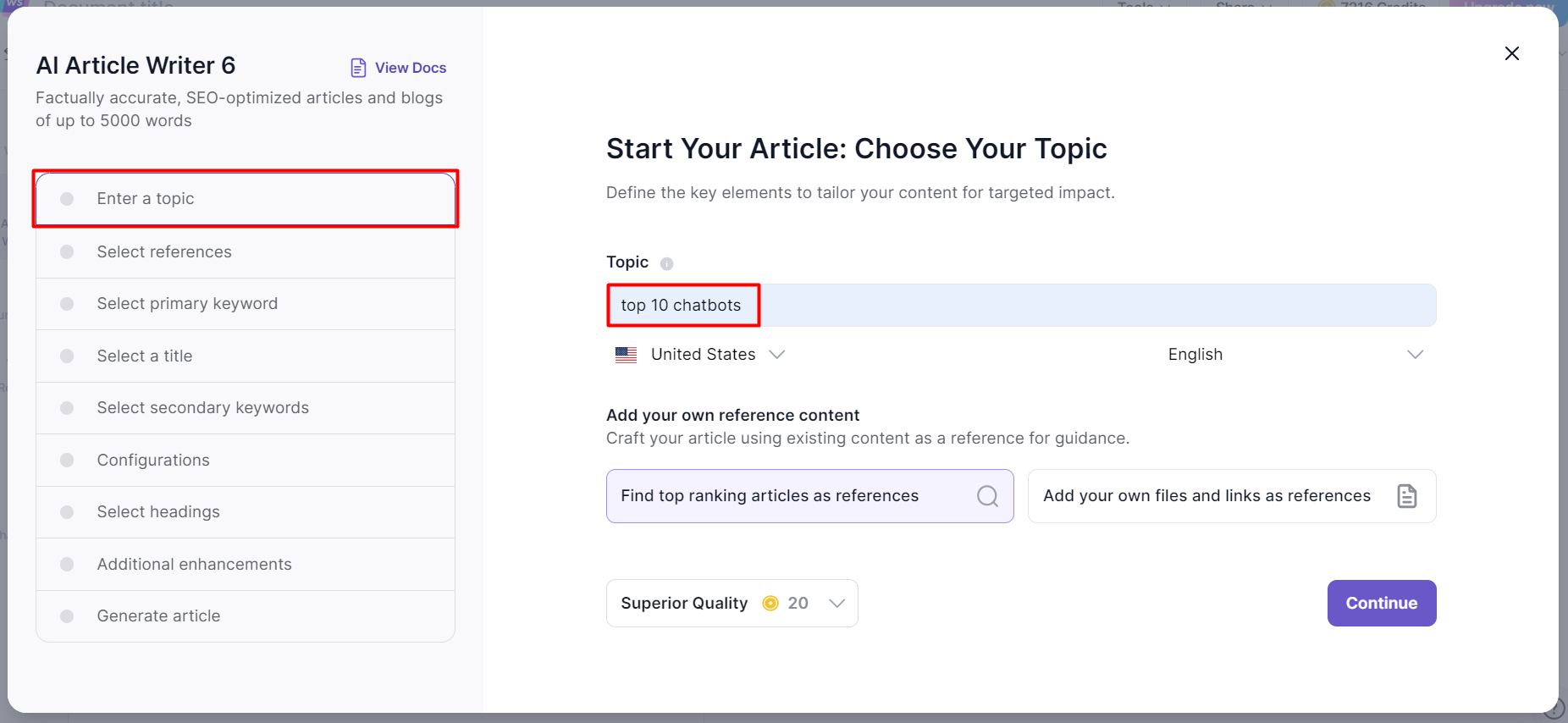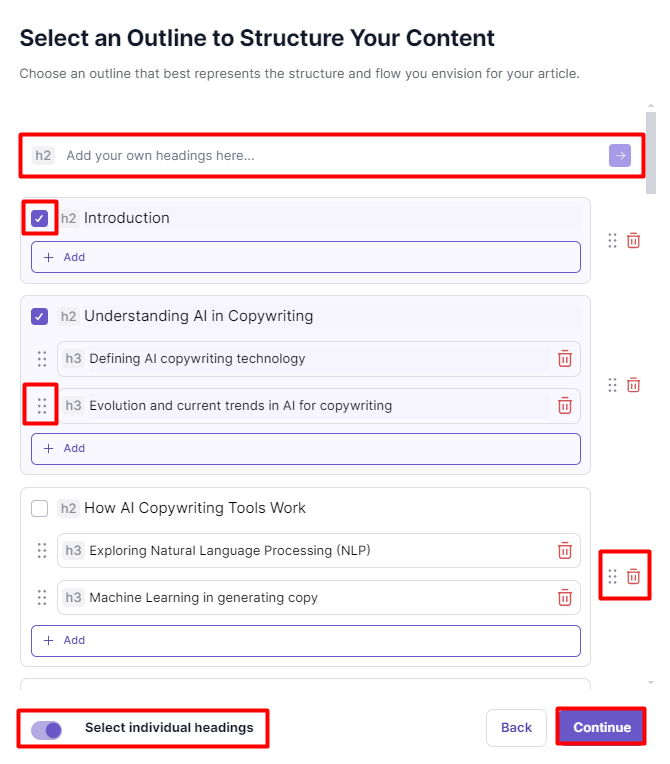AI Article Writer 6
Learn how to create articles with advance content creation to boost online visibility and engagement.
Article Writer 6.0 is Writesonic's flagship tool designed to revolutionize content creation, offering full control from research to personalized brand voice integration. AI Article Writer 6 equips professionals and businesses with powerful tools like tone customization, internal linking, source citation, AI-generated cover images, FAQ integration, and calls-to-action.
AI Article Writer 6 is ideal for SEO specialists, digital marketing agencies, content marketers, bloggers, students, digital agency owners, and content creators, offering advanced features like keyword research to enhance online visibility and engagement, while providing SEO-optimized, factually accurate articles for various needs.
Note: Access to this feature varies based on the specific plan you have chosen.
Step 1 - Navigate to the AI Article Writer 6 Page
- Click [AI Article Writer] from the left hand side menu
- Click [Use AI Article Writer 6]
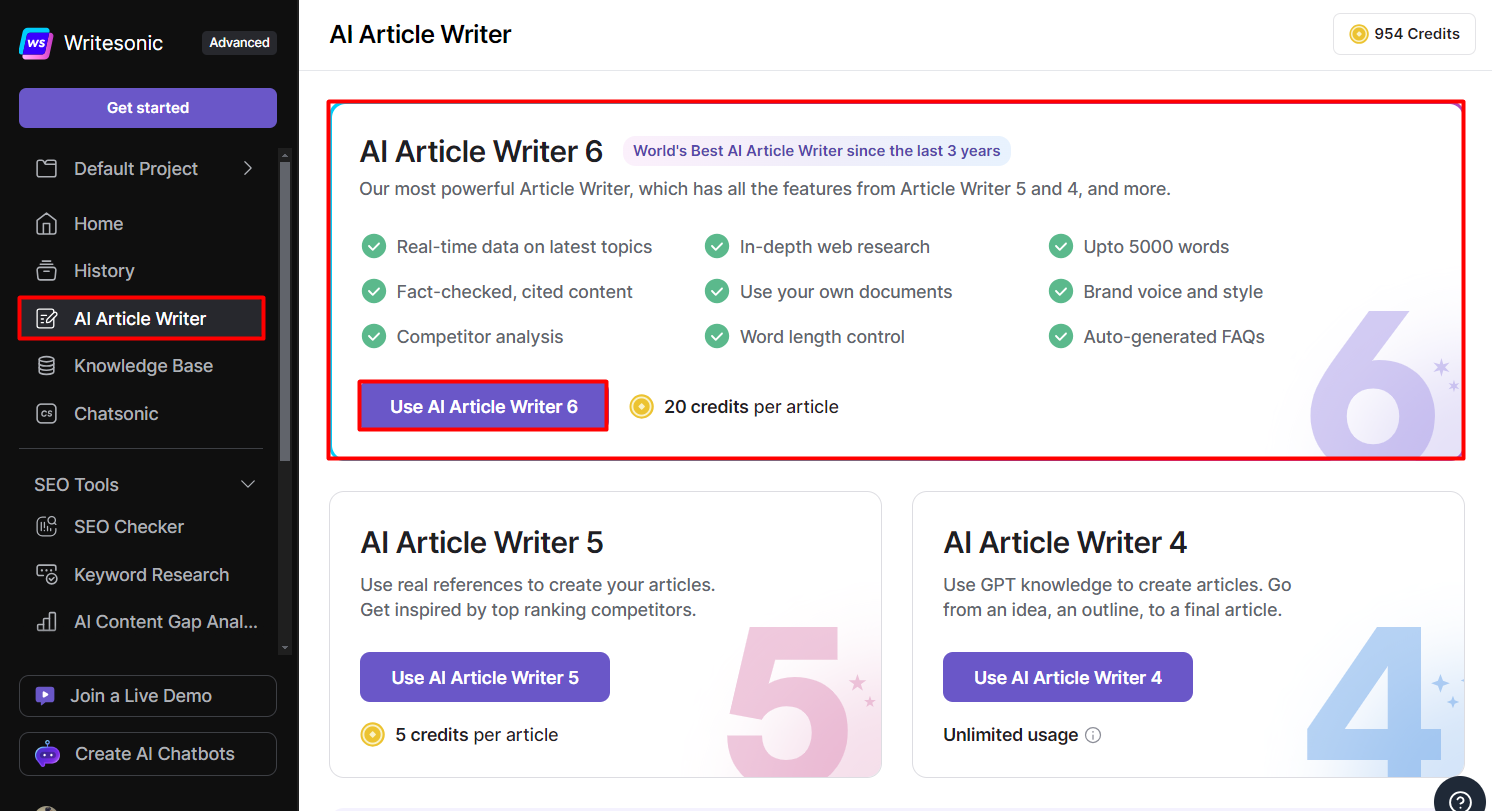
Step 2 - Define the key elements of your article
- Enter a topic to provide the AI with the groundwork to craft a thorough, well-researched, and captivating article.
- Select a country to direct the AI's research and content creation towards that specific geographical region, optimizing for local SEO.
- Select a language for localizing the final generated article. Supported languages include: Bulgarian, Chinese, Czech, Danish, Dutch, English, Estonian, Finnish, French, German, Greek, Hungarian, Indonesian, Italian, Japanese, Korean, Latvian, Lithuanian, Norwegian, Polish, Portuguese, Romanian, Russian and more.
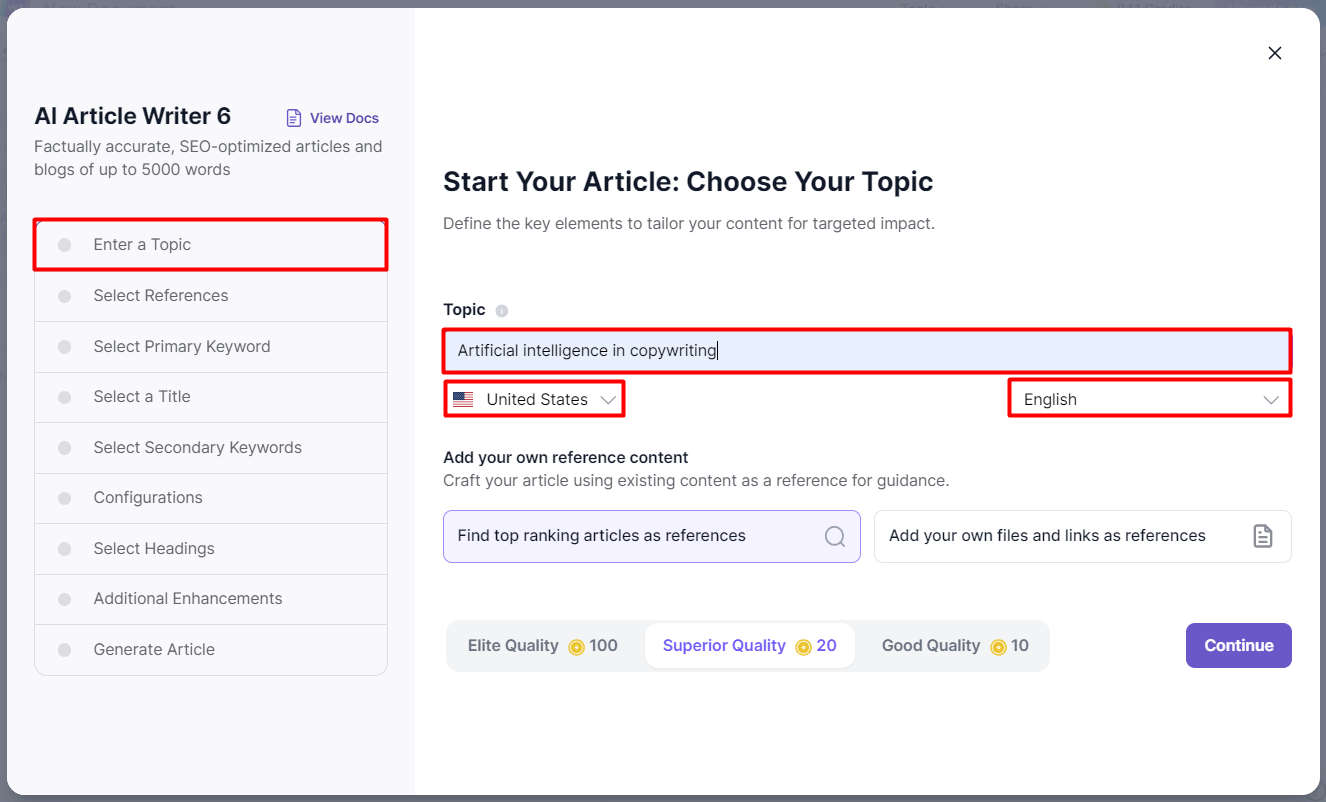
- Select how you'd like to add article references. Writesonic uses these references to figure out the best word count, heading layout, and keyword plan by analyzing competitors and keywords. You have 2 options to select from:
- Find top ranking articles as reference; or
- Add your own files and links as a references
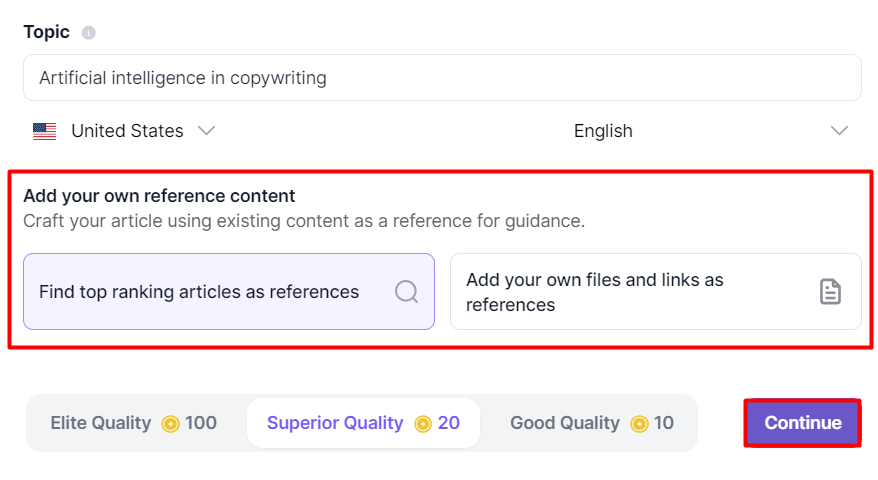
- Click [Continue] to select references.
Generate Listicles with AI Article 6
AI Article Writer 6 also excels at creating engaging listicles. Simply enter a topic such as "Top 10 Chatbots" or "Best Movies to Watch in 2024," and the AI will generate a well-structured article in a listicle format. This feature is perfect for creating content that is easy to read and highly shareable, making it ideal for blog posts, social media, and more.
Step 3 - Select References
Find top ranking articles as reference
- Choose up to 5 references to guide the AI's understanding of your topic. Writesonic analyses these to determine ideal word length, heading distribution, and key word strategy based on competitor and keyword research.
- Click [Continue]
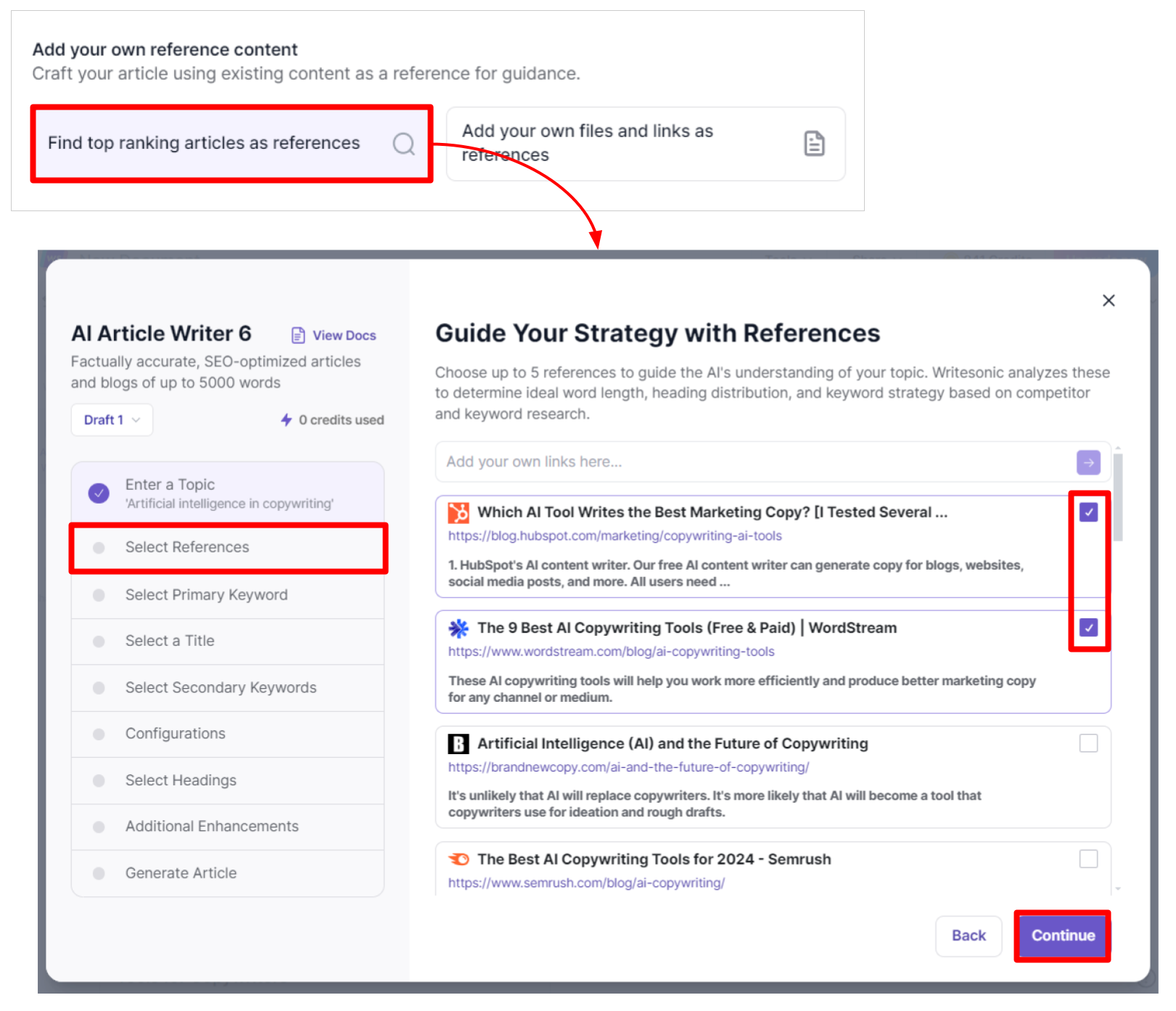
Add your own files and links as references
- Add up to 5 files or links as references to aid guiding the content creation process.
- Click [Continue]
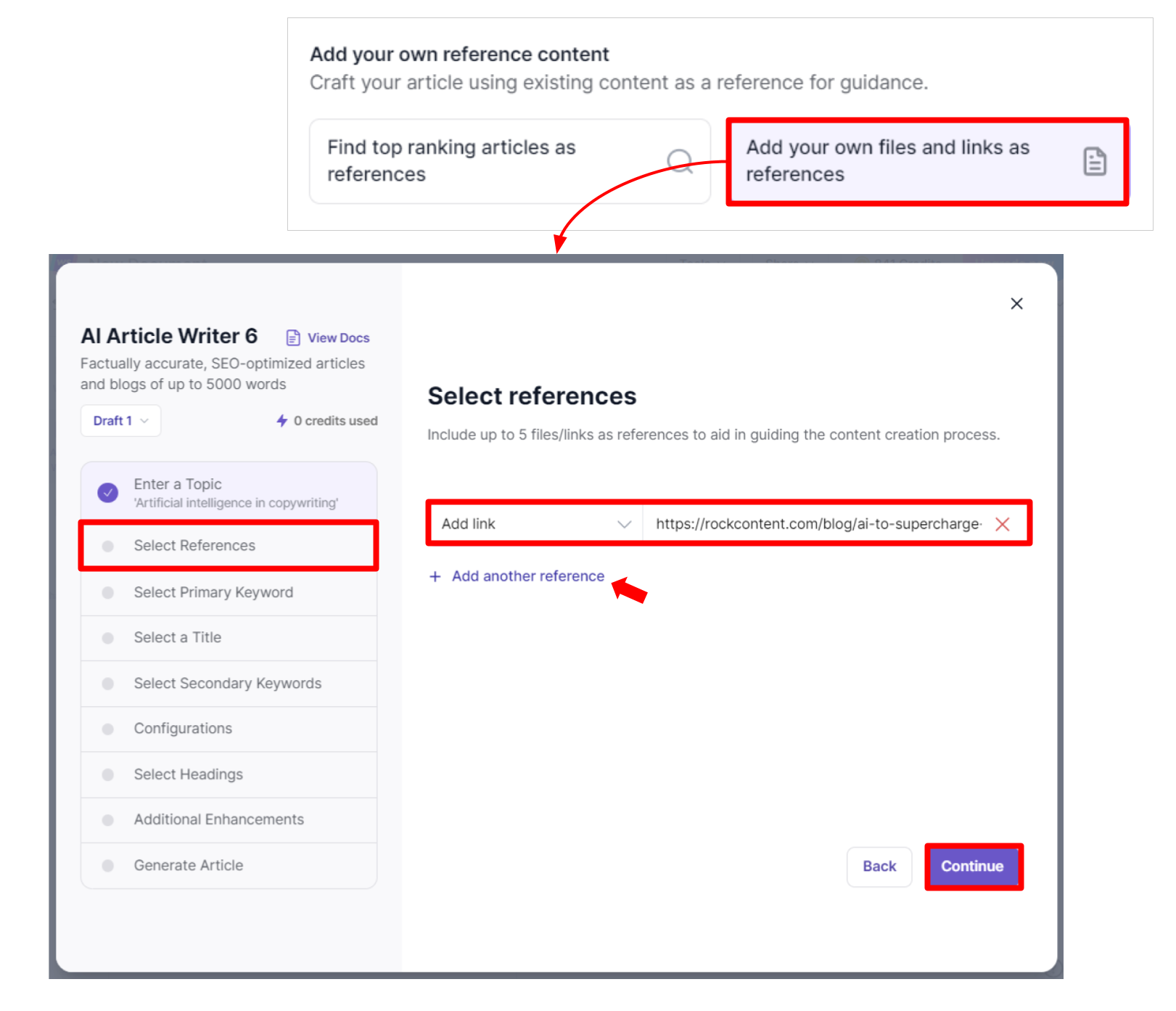
Step 4 - Select a Primary Keyword
What is a Primary keyword?
Primary keywords are the main terms you focus on in your SEO plan. They match the main topic of your content and are vital for your SEO strategy. The AI uses this primary keyword to craft a detailed, well-researched, and interesting article on your selected topic.
- Select the most strategic keyword to anchor your content and drive SEO performance. From the given metrics, choose the keyword with a fine balance between, (Low to Medium) Difficulty and (Medium to High) Volume. You can also add your own keyword.
- Click [Continue]
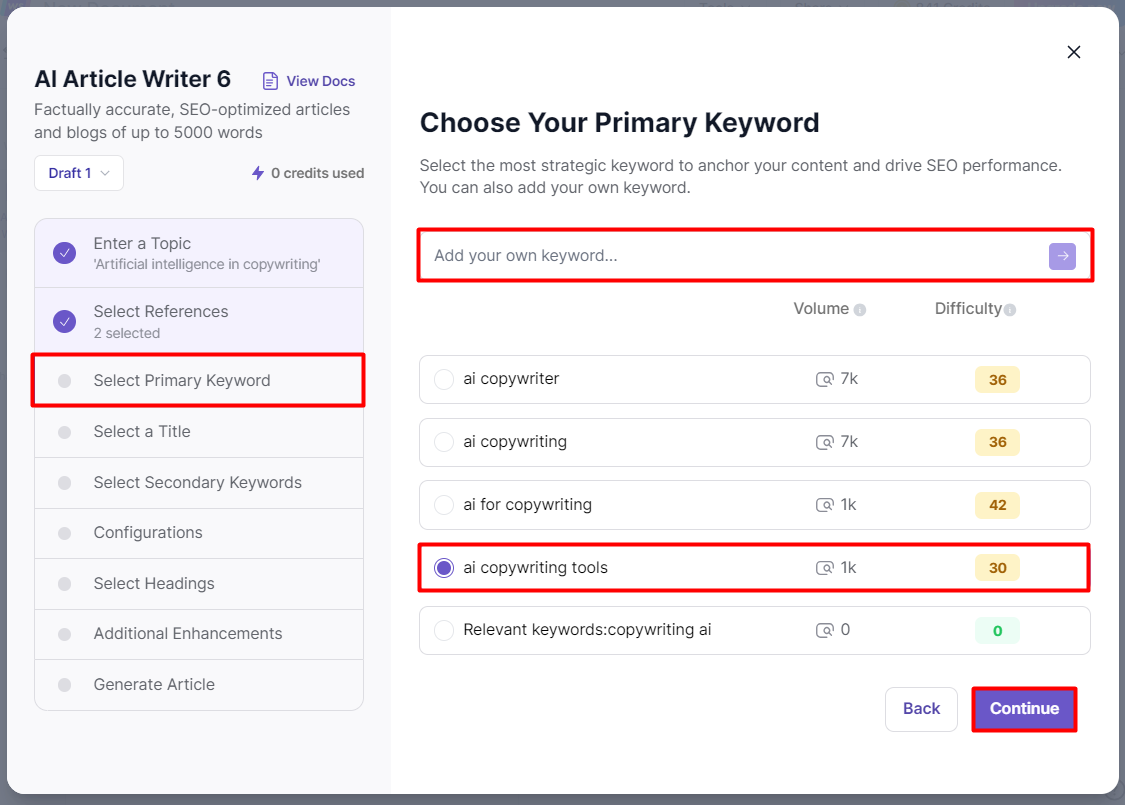
Metrics: Volume & Difficulty Levels
- Keyword search volume refers to the average number of times a keyword is searched for in the past month. Higher volume equals more exposure potential.
- Keyword Difficulty is a useful metric that indicates how challenging it might be to rank for a specific search query. The higher the score, the more difficult it is to rank. Lower scores mean less competition, possibly leading to higher rankings.
Step 5 - Select a Title
- Pick a title from the AI-generated options. Each title option provided is crafted to include your primary keywords, enhancing your content's Search Engine Optimization (SEO). This alignment with SEO strategies effectively boosts your article's visibility and reach, ensuring it resonates with your chosen topic. You can also create your own.
- Click [Continue]
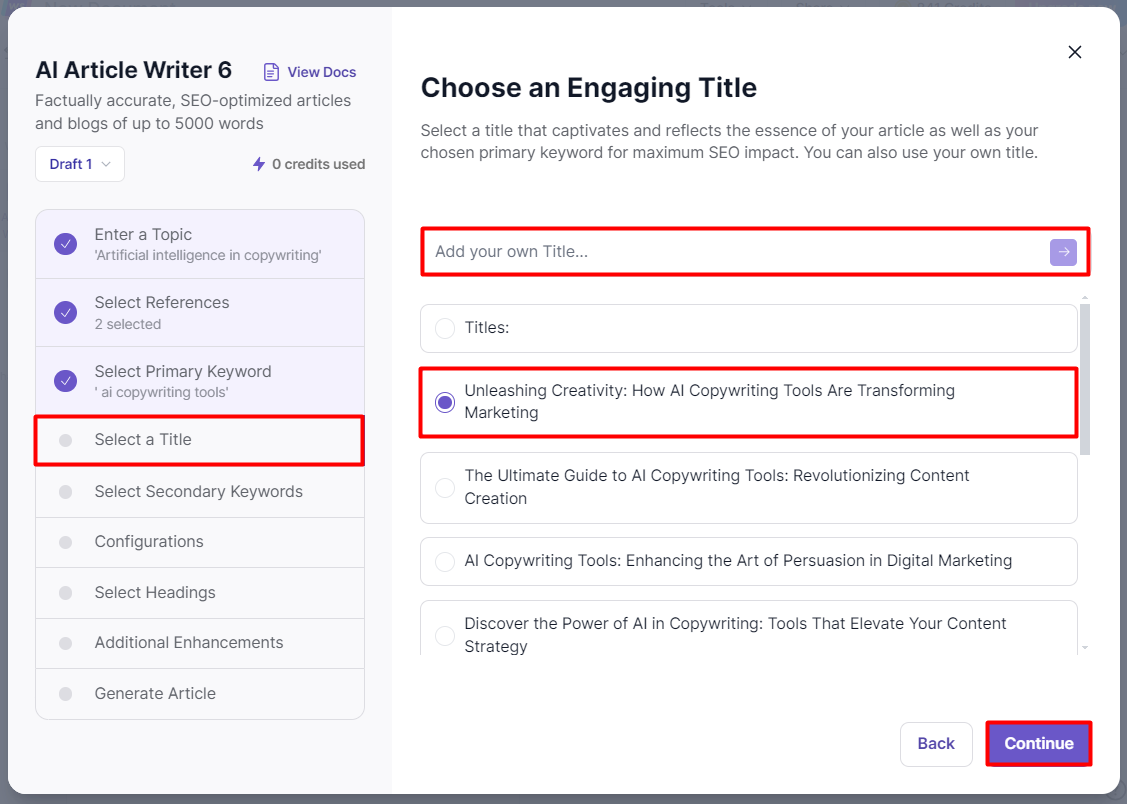
Step 6 - Select Secondary Keywords
- Choose between 5-15 secondary keywords to broaden your content's reach and relevance. Secondary keywords refine your topic and provide extra context for your article, enhancing its depth and breadth. They assist in developing subtopics or related discussions within your main subject matter. Incorporating these keywords into subheaders and text aids Google in understanding your page's content better. You can also add your own, don't forget to use the scroller to see more options.
- Click [Continue]
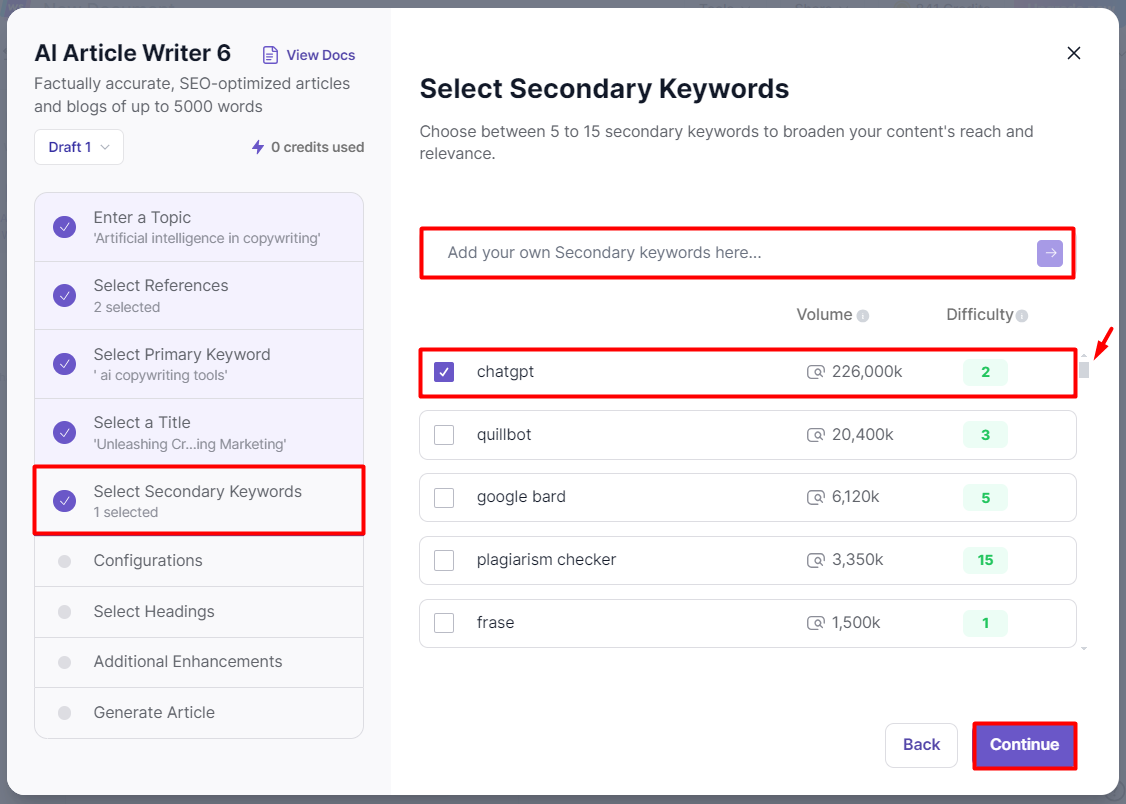
Step 7 - Adjust Configurations
-
Adjust the following settings to align the content with your brand's unique style and requirements
-
Article length - the "SEO Optimized" option is highly recommended. This suggestion is based on the SERP (Search Engine Results Page) analysis conducted in earlier steps. It aims to offer the ideal word count for your article, taking into consideration both SEO best practices and reader engagement.
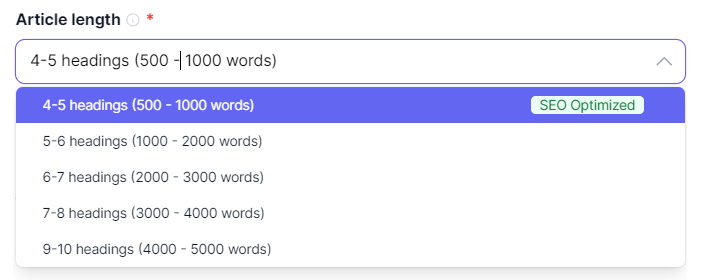
-
Brand voice (optional). You can customize the AI's writing style to match your brand's voice, ensuring consistency in all your content. Inject your brand's tone, style, and more to ensure that the generated content always reflects your brand.
-
If you haven't created one, click [New Brand Voice] to create one.
-
Read this step by step guide on how to create a Brand Voice.
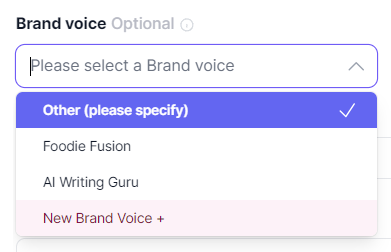
-
-
Point of view from which the article will be written. Point of view is shown through pronouns that reveal the narrator's position.
-
First Person: The author's perspective. Great for personal stories or op-eds, creating a personal connection. Example: "Every morning, I make it a point to go for a brisk 30-minute walk. This routine has not only improved my physical health but also my mental well-being. Let me share with you how integrating exercise into my daily schedule has changed my life for the better."
-
Second Person: Directly addresses the reader. Effective for instructional content, engaging the reader. Example: "Imagine starting your day with a burst of energy that lasts until the evening. By dedicating just 30 minutes to exercise each morning, you can experience significant improvements in your health and mood. Let's explore how making this simple change can transform your life."
-
Third Person: A detached perspective. Suitable for news articles or reports, presenting information objectively. Example: "Individuals who incorporate at least 30 minutes of exercise into their daily routine experience a myriad of health benefits. Studies show that regular physical activity can lead to improvements in cardiovascular health, mood, and overall quality of life. This article delves into the science behind the benefits of daily exercise."
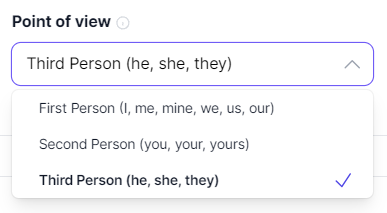
-
- Tone - Your content's tone matters a lot in how readers understand it. Whether your brand sounds professional, funny, witty, excited, relaxed, or inspiring, Writesonic's AI can adjust to match, making sure your content connects with your audience.
- Additional Instructions - Share any specific instructions or preferences you have for the article's creation. These could include points you want detailed, a unique perspective you'd like focused on, or any other guidance to align the content with your needs. Whether it's a certain approach, style, or viewpoint, these instructions are crucial for tailoring the content to your requirements.
-
-
Click [Continue]
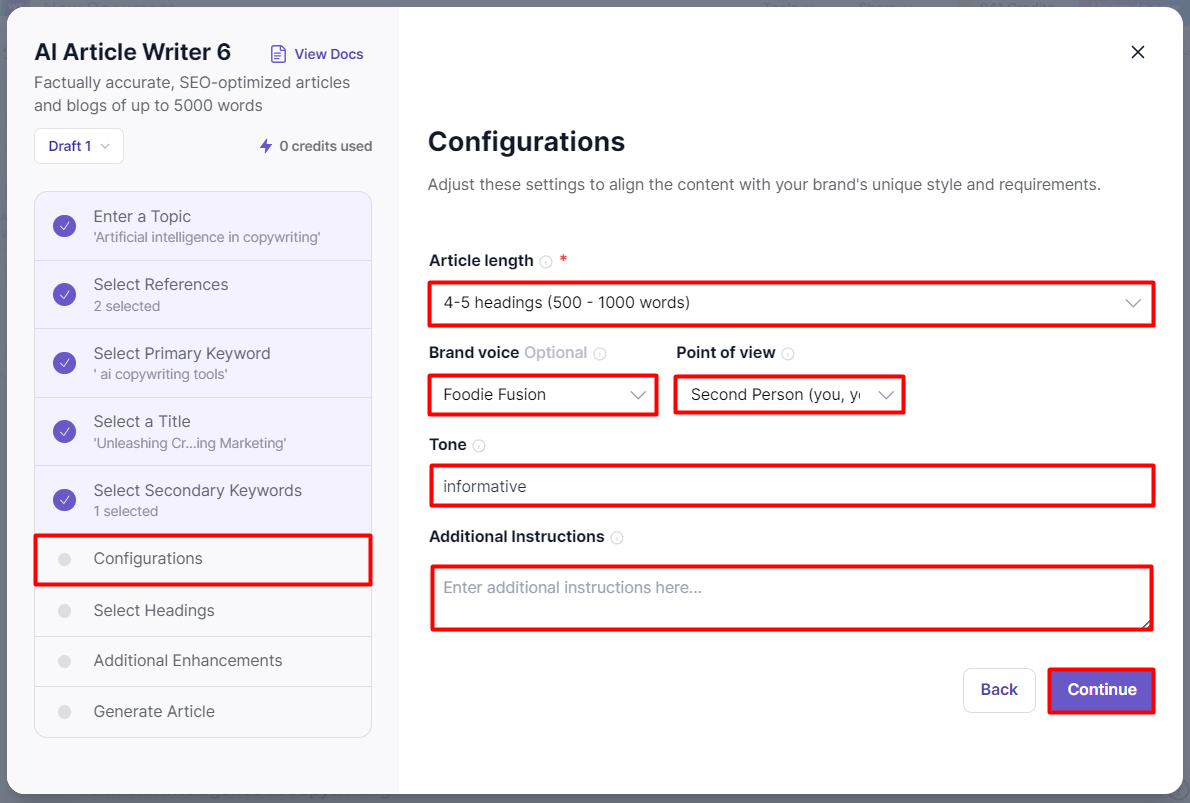
Step 8 - Select Headings
What are Headings and How Do They Work?
Headings are crucial for organizing articles, breaking them into clear sections. Each heading represents a new topic, guiding readers through the content. This improves readability and helps readers find information quickly. Effective headings are essential for creating a well-structured, high-quality article.
- Click to select an outline to structure your content
- Click [Continue]

Alternatively, you can toggle ON to select individual outlines
Check or un-check the outline titles to include in your content, edit heading titles, re-arrange the order of the headings, and/or delete them from the list
Step 9 - Adjust Additional Enhancements
-
Select (or unselect) the following enhacements you want to add on your article:
-
Generate FAQs to address common queries at the end. The FAQ section is designed to enhance your content's relevance and SEO, using SERP analysis to find commonly searched questions. Including FAQs to your content . boosts user engagement, adds value for readers, and may improve your content's search ranking.

-
Internal Linking - add your your top level domain to auto-add links. Adding internal links to your article can greatly improve your website's visibility in search results. These links direct readers to other relevant pages on your site and help search engines understand your site's content structure and hierarchy.

-
Add citations - add sources as links or footnotes. Citations make the article more credible and offer readers references for more information. By linking to reliable sources, it ensures your article is based on trustworthy data, making it more reliable. Plus, it provides additional resources for readers to learn more about your topic.

-
Generate a cover image - get an AI generated image for your article

-
Include a Call-to-action if you want to encourage users to take action. Adding a call-to-action tells readers what to do next after they've read the content. This guides them towards desired outcomes like making a purchase, subscribing, or engaging further. It boosts conversions, engagement, and builds a stronger connection with your audience.

-
-
Click [Generate] to generate the article.
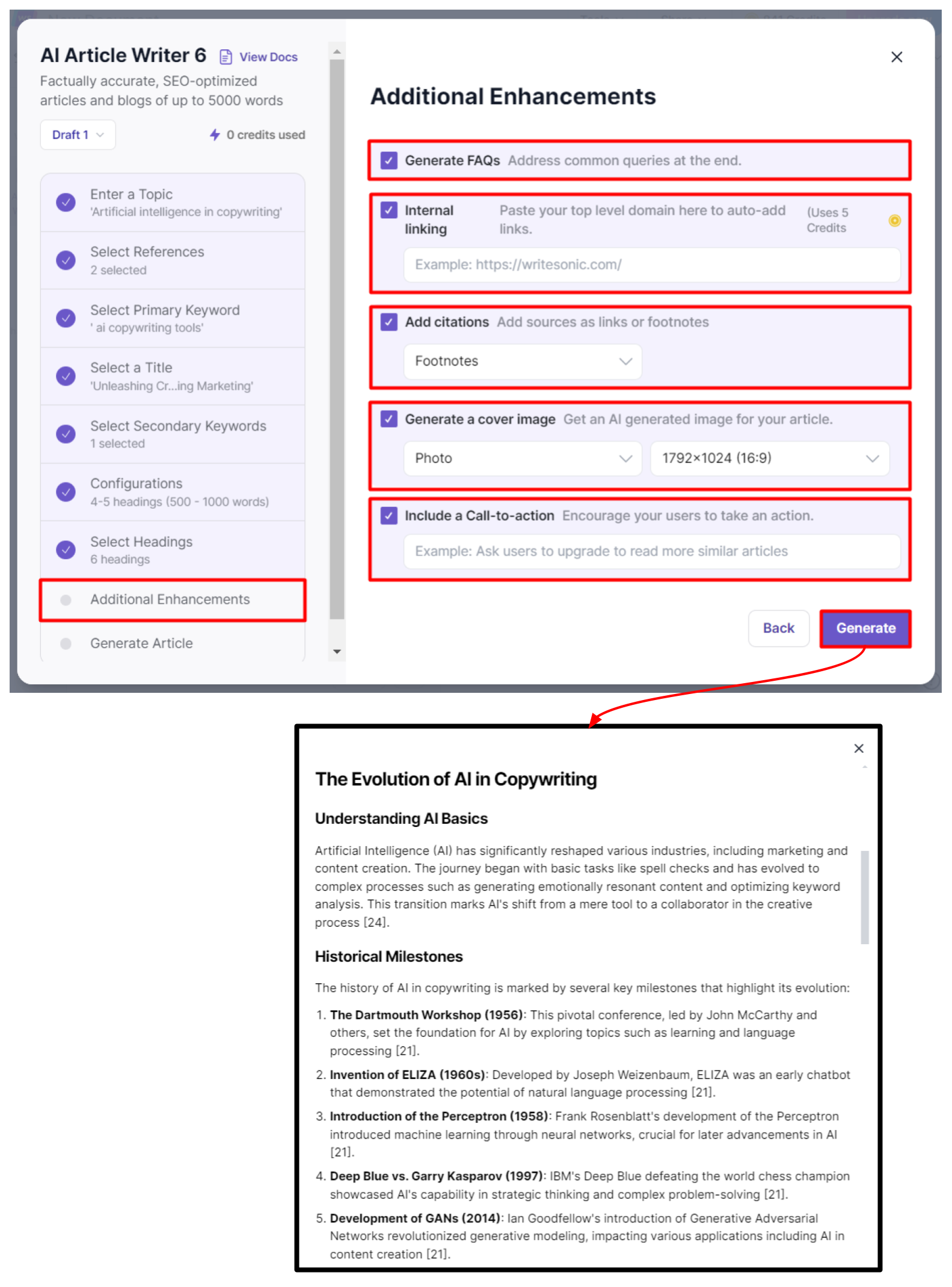
Step 10 - Generate the Article and Start Editing
Once the article has been generated, you can:
- Generate another version - click the [Regenerate] button
- Download the article into a PDF file
- Start editing the article - click the [Start editing] button to open the article in the AI Document Editor. To learn more, read this step by step guide on how to use the AI Document Editor.

Updated 3 months ago

